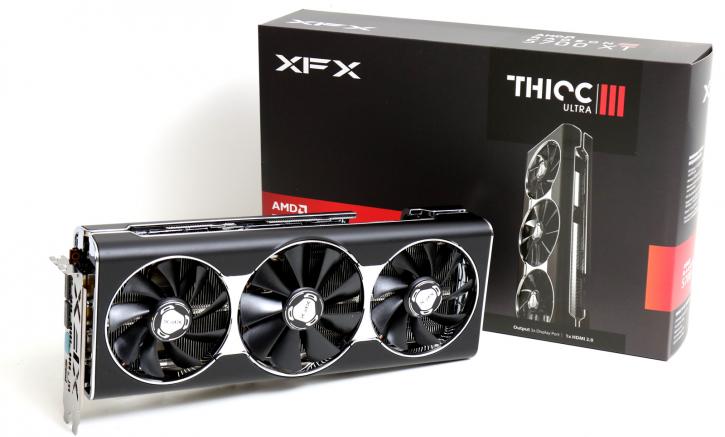Introduction
XFX Radeon RX 5700 XT THICC III ULTRA
THICC times 3 - you know you like it
Extra, extra, extra THICC. Yes, don't get confused in a deja-vu moment as we indeed already reviewed the THICC II, this is the THICC III edition of the XFX Radeon RX 5700 XT. This brother from another mother is slick and extra thick. A new cooler has been applied that offers not one, not two but you guessed it already, it has three fans and a rather snazzy RGB free look, that's right .. no RGB y0.
It has been quite a journey for AMD, but it is the year 2019 and the chip producing industry is ready with their new silicon wafer fabrication at 7nm. AMD hasn't been wasting any time, Ryzen 3000 at 7nm, Radeon VII at 7nm, and today we bring you a review of both the Radeon 5700 and 5700 XT. The basis of the product that we test today is the NAVI GPU, with a die fabbed at a 7nm fabricated package and 8GB of GDDR6 graphics memory these cards are released in an aim to compete with the GeForce RTX 2060 and 2070, will it be capable to do that? We can already tell you that the numbers will be interesting to see. The most important aspect, however, is pricing. AMD wanted to tackle two price points for NAVI, for the familiar frame of mind let's call the Radeon RX 5700 the PRO revision and then the Radeon RX 5700 XT GPU versions. So the new Radeon RX 5700 and 5700 XT will cost 349 and 399 USD respectively. As we all know NAVI is the new family of mainstream to high-end (but not enthusiast) Radeon GPUs. NAVI is based on what AMD refers to as RDNA architecture (Radeon DNA). The Radeon 5700 series will also be the first commercial consumer graphics card that is PCIe Express 4.0 compatible. AMD today will launch the reference products, the AIB card with custom designs and cooling will follow in the weeks to come. Reference first though, Radeon 5700 is a GPU with 2304 stream processors. The GPU game clock is dynamic at 1.6 GHz with a peak boost clock to 1.7 GHz. It's bigger brother is the Radeon RX 5700 XT, with a fully enabled NAVI chip it has 2560 shader processors active. Its average game clock will hover in the 1.75 GHz but can boost to 1.9 GHz. We do wish AMD would not make a distinction between a game and max boost clock though as it is just too confusing for the majority of consumers. Both NAVI cards are fitted with GDDR6 memory, that means HBM2 is no longer used opposed to what you have been seeing with Vega 56/64, a clever choice as HBM2 memory is difficult to assemble onto the die substrate (lot's of yield issues there) and that makes it very expensive, next to being an expensive memory type to purchase. What AMD did well is that they have opted for that 8GB GDDR6 graphics memory to run at 14 Gbps, which is nice and fast graphics memory at just the right volume size.
XFX Radeon RX 5700 XT THICC III ULTRA
In our previous THICC II review, we had some comments about the design and cooler in specific. A new round with new chances for the THICC III model. While the Radeon RX 5700 XT THICC III Ultra carries a similar looking design to the THICC II Ultra you will find differences in the dimensions, you guess it, it is THICCer with a 2.7 slot design. Whilst the TGP/TDP power target defines performance these days, XFX did THICC around a bit with clock frequencies. And these would be 2025 MHz as MAX Turbo and a Game clock of 1935 MHz while the base clock is set at 1810 MHz. Triple fans have been applied with fan extra blades (11 vs 9), two fans on the sides are 90mm wide the middle one is a bit THICCer at 100mm. The board is fed by two 8-pin power connectors and shows a surprise or two as the Ultra version, not only has been fitted with a gorgeous looking cooler, it offers a notch more performance as the team has increased the power allowance towards (we think) 210 Watt at defaults, so it will have higher sustained boost clocks than the standard 5700 XT cards that have been seen on sale. It has a dual-BIOS mode that allows you a silent and performance option but even the performance mode now is very tolerable in acoustics thanks to the bigger cooler. The card features 8 GB of GDDR6 memory running at 14 Gbps along with a 256-bit bus interface, delivering bandwidth of 448 GB/s, that GDDR6 memory has been not been tweaked, the ICs are stock 14 GHz (effective clock-rate) but can be bumped upward towards 15 and maybe even 16 GHz. We'll peek at that in our tweaking segment of this article. The card offers one HDMI 2.0b ports and three DisplayPorts v1.4. As mentioned in the introduction paragraph, the card does not have anything RGB or LED on it, and you know what .. it's one of the better-looking products we've seen in a while, albeit it all is a lot of plastic on that outside. We'll start with a product overview in the photo-shoot, but have a quick peek first after which we then head onwards into the review.


